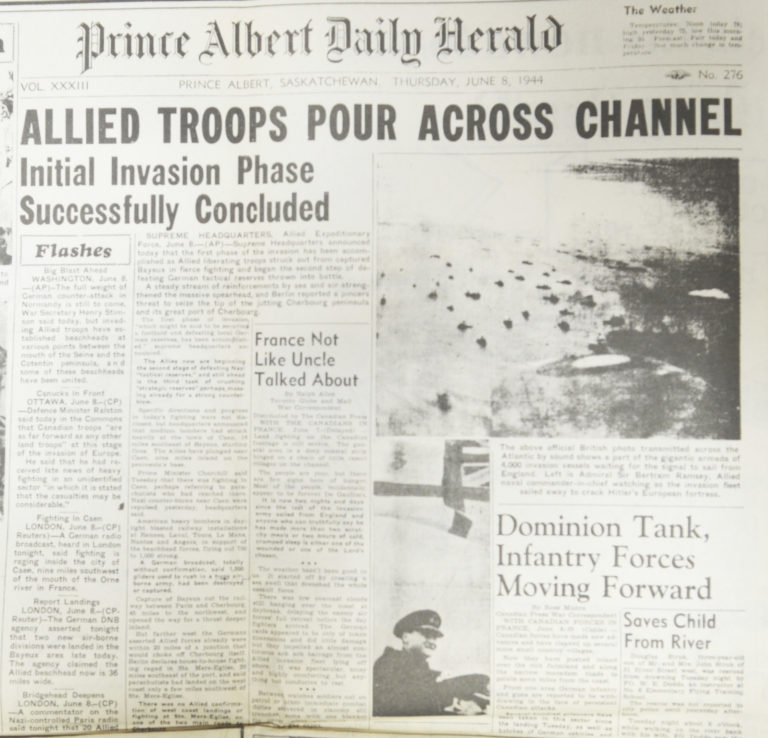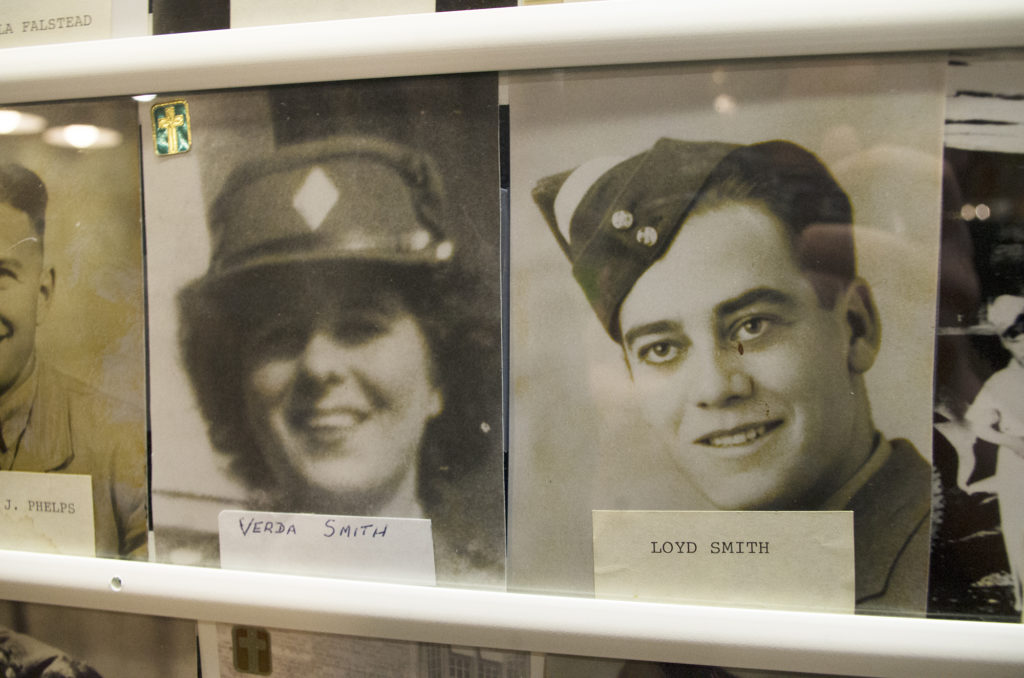
Lee Gisi’s feelings on D-Day have evolved over the years.
As a young 17-year-old, confident and eager to join the Canadian military, news of the Allied invasion of France was exciting. That didn’t last.
“In those days, at 17, I was young and afraid of nothing,” Gisi remembers. “Not only that, (I thought) I was bullet proof. I think of it now, and it’s 74 years ago. I’m 91 now, going on 92. I read enough about it and then I heard enough about it from my cousins who came back, cause I had a pile of them in there.”
Gisi comes from a large family, most of them from the Estevan area. When the Second World War broke out, his cousins joined up en masse, largely with either the South Saskatchewan Regiment, or with Canada’s airborne division.
They were all farm boys, valued because they could do anything from harness a horse to drive a truck to fire a rifle or a shotgun. Not all of those cousins made it back home.
A few are buried in the Netherlands, two were lost in the North Atlantic, and one died on June 6, 1944 at Juno beach. A few years ago, Gisi and two of his daughters went over to pay their respects.
“I have visited (Juno) on several occasions,” he says. “I have done a little kneeling and a little praying and a little crying there.”
Gisi never got to Europe as a soldier. He trained in Tisdale under the tutelage of the Prince Albert Volunteers until he was old enough to officially sign up. He became a paratrooper, and spent the winter of 1945 making practice jumps with the rest of his training unit in Saskatchewan’s far north.
When spring came, he was one of roughly 15,000 soldiers from Western Canada on a train bound for Trois-Rivieres, Que., where four troop transport ships waited to take them to Europe. They arrived in Quebec on May 6, 1945. Germany officially surrendered on May 7.
As a devoted student of military history, Gisi has read a lot about D-Day. With the event’s 75th anniversary approaching, he’s grateful for the sacrifice his cousins made, but wishes the Canadian government had done more to promote the contributions made by Canadian soldiers.
“I was very disappointed with our defence department, and maybe our veterans too, but Canadians aren’t much to talk like me,” says Gisi, who came back to Prince Albert after the war and served on a number of local civic boards, including 16 years on city council. “I’m a yappy old guy, so it’s easy for me.”
Part of the problem, he says, is there are very few people around to talk about it. Most D-Day veterans are in their 90s. Many have passed away, while others aren’t healthy enough to speak publicly.
Even if they were, however, Gisi doubts they’d be quick to talk.
“The old soldiers who were in the heat of the battle where the bullets were flying all the time and they were throwing grenades, you had to get them half intoxicated before they would really talk,” he says. “Otherwise they wouldn’t say a word about it. They just couldn’t talk about it.”
‘A real nightmare’
News of Canada’s D-Day victory didn’t reach Canada immediately. The first article in the Prince Albert Daily Herald didn’t appear until June 8.
For Canadians at home, that wait could be excruciating.
“By the time we heard about it, some of the veterans were on their way back home,” Prince Albert Royal Canadian Legion member Marie Mathers remembers. “I know one of my father’s close friends was killed and the family never found out until pretty much five weeks after D-Day. Like I said, it was a real nightmare.”
On June 6, 1944, Mathers was working at a camp for German POWs in St. Jean Baptiste, Man. Her then boyfriend and future husband Robert Mathers was among those who landed at Juno Beach.
Although Robert lived, several of his close friends didn’t. He rarely talked about his experiences that day, even with his wife.
“It gives me the chills, to start with, to think that my husband was fortunate enough to survive,” Mathers says. “Two of his buddies were killed right beside him when they got off the ship. He never talked too much about it—only when he had been drinking. Then he would open up. It’s a nightmare that came true. That’s the only way I can really put it.”
While D-Day marked an important turning point in the Allied victory, things got tough back home. Money dried up for many local families, who had to rely on coupons to purchase food rations.
Mathers says it was worth the sacrifice, especially considering what her husband was going through. As the 75th D-Day anniversary approaches, she hopes current and future generations will remember that sacrifice and respect it.
A birds-eye view

There were 37 Royal Canadian Air Force squadrons that saw action on June 6, 1944. By the end of the month, RCAF tail-gunner Loyd Smith was on his way to join them.
Smith was 19-years-old on D-Day–the youngest of eight kids born to a homesteading family from Choiceland, Sask.–and waiting to board a troop ship for the long trip across the Atlantic. He remembers little about D-Day, save for a few thoughts of his two older brothers who were already there.
“When you’re 19, you don’t worry too much about anything,” Smith says. “I remember hearing about D-Day … and wondering if my brothers were in it.”
“D-Day was kind of exciting to hear, but we didn’t know what the hell war was.”
Smith’s brothers weren’t part of the initial assault, but they did join the Canadian army in France in the days that followed.
When Smith arrived in England, his crew drew a tough assignment. Instead of boarding the fresh, new Lancaster Bombers that began rolling off the assembly line in 1943, they hopped on the old Vickers-Wellington Bombers that were in service since the start of the war.
Their mission? Fly a “diversion raid” designed to sucker German fighters into chasing after them while the main bomber force approached the target from a different direction.
“We were to go up in an old Wellington and go in to just about over the front lines and do a U-turn and come back,” Smith remembers. “That was kind of exciting. We got up there and you’re up in the sky with planes all around you, and you got about 30 of us.”
“Then it got dark—no moon—and you didn’t see another damn plane. I didn’t even think of enemy planes. I thought, ‘well, we’ll run into (each other) because we’ll go and make a turn and with everybody making their own turn, we won’t all be (turning) at the same time.’ But, we didn’t hit anybody.”
Smith and his crew would fly for three or fours hours at a time like that, an experience he describes as ‘not too much fun.’ Still, he says it’s not as bad as what Canadian soldiers, and his fellow Canadian airmen, went through on D-Day.
“The guys who were overseas in the air force did a lot of flying that day,” he says. “The guys who didn’t have much to do with (flying), I knew a few who went over there and I guess it was something scary. A guy from P.A. here, I remember him talking about it. He said he couldn’t swim. He got off the damn boat and the water was over his head and he was trying to keep his gun out of the water. It was a hell of a thing.”
Smith returned to Canada in July 1945, a little over a year after departing. He initially worked at his father’s sawmill, but soon moved to Prince Albert where he met his wife, Verda, who passed away in 2000.

He missed flying, so after a few years he re-enlisted. The only problem was that technological improvements meant the air force had no need for tail gunners.
That didn’t matter though. He joined the grounds crew, and served in the air force for another 25 years.
Smith is 94-years-old now. As D-Day’s 75th anniversary approaches, he wants people to remember the soldiers, sailors and air crews whose lives ended far earlier than they should have.
“All those lives that were lost, they were all young,” he says. “If we saw somebody 30 years old, we’d probably call him ‘Dad.’”
Events commemorating the 75th anniversary of D-Day and the Battle of Normandy will be held throughout Canada on Thursday, June 6. The main tribute will be a wreath laying ceremony at the National War Museum in Ottawa, starting at 11 a.m. local time.
More than 14,000 Canadian troops landed on Juno Beach on D-Day, and more than 110 Royal Canadian Navy vessels and 10,000 sailors contributed to the operation.
A total of 37 RCAF squadrons flew at least one mission, including 15 fighter and 15 bomber squadrons, while more than 500 paratroopers from the First Canadian Parachute Battalion jumped into France.
Canadian forces suffered more than 1,000 causalities on D-Day, including 359 dead.
Correction: A previous version of this article incorrectly stated the location of a POW camp in Manitoba. The article has since been corrected. The Daily Herald apologizes for the error.
